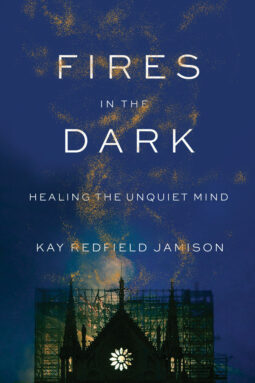Fires in the Dark
Kay Redfield Jamison
Knopf, $30
Mentally and spiritually devastated after surviving World War I’s combat horrors, British poet Siegfried Sassoon was treated for emotional wounds at a military hospital. He wrote a poem for his psychotherapist that included these lines:
Fires in the dark you build; tall quivering flames
In the huge midnight forest of the unknown
Kay Redfield Jamison takes the title of her new book, Fires in the Dark, from Sassoon’s vivid image of how medical psychologist, physician and anthropologist W.H.R. Rivers tended to his psychological war wounds. Jamison uses writings by both men to explore Sassoon’s therapeutic relationship with Rivers. Their story forms part of a deeper probe into how psychological pain can be healed and what it takes to be a great healer. Jamison writes movingly about topics ranging from the workings of ancient Greek healing temples to the tribulations of World War I nurses facing the limits of healing soldiers’ ravaged bodies and minds.
Jamison, a psychiatrist herself, has previously written about her personal experience with bipolar disorder, which informs this literary journey into healing (SN: 4/8/00, p. 232).
Since the dawn of humankind, certain individuals — who combine compelling personalities, a stout character and superior people skills — have stood out as healers of what Jamison has previously described as “unquiet minds.”
Effective healers accompany sufferers on a journey toward wellness, she writes. Healing tools include the deft use of suggestion, confession, memory, ritual and medicines. Healers find ways to provide consolation and hope, enabling their wounded charges to engage with meaningful work and find purpose in life.
That theme reverberates in Jamison’s account of how Rivers treated Sassoon, whose war reactions might today be diagnosed as post-traumatic stress disorder. As an anthropologist, Rivers had learned about and witnessed healing rituals and supernatural beliefs of different cultures. He had written that “psycho-therapeutics would seem to be the oldest branch of medicine.”
Rivers struck colleagues and those he treated as forceful but caring, demanding but sympathetic. Sassoon wrote that he liked and trusted Rivers within minutes of meeting him. After listening to Sassoon relate his traumatic war experiences, Rivers focused on the soldier’s memory and imagination as key healing elements.
Rivers encouraged Sassoon to use poetry to memorialize friends and soldiers he had commanded but who had not survived. As verses of remembrance and grief accumulated, Sassoon achieved a measure of control over the war’s terror and futility. Feeling a sense of guilt and responsibility for soldiers still fighting, Sassoon returned to the war.
Psychotherapy as practiced by Rivers had roots in the powers of suggestion wielded millennia earlier by priests and sorcerers, Jamison writes. Ancient Egyptians and Greeks, for example, called on priest-physicians who performed early types of surgery, chanted against disease-causing spirits and used magic spells to amplify patients’ responses to medicinal potions.
Jamison includes a fascinating description of ancient Greek healing temples run by followers of Asclepius, the god of medicine. In settings designed to be peaceful refuges, individuals with mental maladies received a special herbal ointment made from imported ingredients. Sufferers were encouraged to enter meditative or hypnotic states and to tell their dreams to temple healers. Dream content guided treatment recommendations.
Therapists today practice a range of purely secular techniques, though they still hark back to the days of Asclepius, Jamison says. Scientifically supported approaches rest on a time-tested need for therapists to gain clients’ trust and nurture self-understanding and hope for improvement (SN: 11/5/05, p. 299). That’s truer than ever in an era characterized by the well-funded promotion of medications and brain technologies over mere “talk” as keys to vanquishing mental problems.
As recently as the 20th century, Jamison writes, mental health clinicians emphasized general features of psychotherapy that promote healing. Psychiatrist and psychologist Jerome Frank, for instance, influentially argued in a 1961 book that any successful form of psychotherapy counteracts the demoralization of those who experience the world as chaotic.
Jamison also delves into examples of the healing powers of music, art, drama and public rituals of remembrance. She includes the poignant story of how, thanks to an Anglican army chaplain, remains of the Unknown Warrior came to be buried at Westminster Abbey in 1920 in a ceremony that lessened the postwar grief of people across Britain. Healers often find it difficult to untangle why their efforts sometimes light fires in the dark and other times fizzle out. Jamison’s stories of healing outline a process that’s still emerging from Sassoon’s huge midnight forest of the unknown.
Buy Fires in the Dark from Bookshop.org. Science News is a Bookshop.org affiliate and will earn a commission on purchases made from links in this article.


